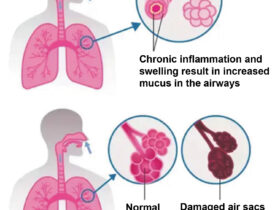By Russell Becker, DO
Carotid artery disease is one of the leading causes of stroke, affecting millions of Americans each year. As we observe Stroke Awareness Month, it’s crucial to understand this often silent but dangerous condition that can dramatically impact quality of life without warning.
The carotid arteries are major blood vessels that run along both sides of your neck, delivering oxygen-rich blood to your brain. When these vital pathways become narrowed or blocked due to plaque buildup—a condition known as carotid artery disease or carotid stenosis—stroke risk increases significantly.
What Causes Carotid Disease?
Atherosclerosis, the same process that leads to coronary artery disease, is the primary culprit behind carotid disease. This progressive condition occurs when fatty deposits, cholesterol, calcium, and other substances build up along the inner lining of arteries, forming plaque that narrows these critical blood vessels.
Several factors increase the risk of developing this condition:
. High blood pressure
. Smoking
. Diabetes
. High cholesterol
. Family history
. Advanced age
. Obesity
. Physical inactivity
What makes carotid disease particularly dangerous is that it often produces no symptoms until it becomes severe or until a stroke occurs. This “silent” nature means many people remain undiagnosed until a serious event happens.
The Relationship Between Carotid Disease and Stroke
When carotid arteries become narrowed or blocked, two primary stroke mechanisms may occur:
1. Reduced blood flow: Severely narrowed arteries can reduce blood flow to brain tissues, potentially causing a stroke if blood supply becomes critically low.
2. Plaque rupture: More commonly, pieces of plaque can break off and travel to smaller brain arteries, blocking blood flow and causing an ischemic stroke.
These strokes can have devastating consequences including paralysis, speech difficulties, memory problems, and even death. Each year, more than 795,000 Americans experience a stroke, with carotid disease being responsible for approximately 20-30% of these cases.
Recognizing the Warning Signs
While carotid disease itself may be asymptomatic, transient ischemic attacks (TIAs) or “mini-strokes” often serve as warning signs. These temporary episodes typically last less than five minutes but should never be ignored. Signs include:
. Sudden weakness or numbness in the face or
limbs, especially on one side of the body
. Sudden confusion or trouble speaking
. Sudden vision problems
. Sudden dizziness or loss of balance
. Sudden severe headache
During Stroke Awareness Month, medical professionals emphasize the importance of the “FAST” acronym for recognizing stroke symptoms: Face drooping, Arm weakness, Speech difficulties, Time to call emergency services.
Diagnosis and Screening
Screening for carotid disease is especially important for those with risk factors. Diagnostic tools include:
. Physical examination with stethoscope (listening for carotid bruits—abnormal sounds indicating turbulent blood flow)
. Carotid ultrasound (non-invasive imaging)
. CT angiography or MR angiography
. Carotid angiography (more invasive but highly detailed imaging)
Treatment Options
Treatment depends on the severity of the stenosis and individual risk factors:
For mild to moderate disease, doctors typically recommend:
. Lifestyle modifications (smoking cessation, healthy diet, exercise)
. Medications to control blood pressure and cholesterol
. Antiplatelet therapy (aspirin or clopidogrel)
. Regular monitoring
For severe stenosis or symptomatic disease, interventional procedures may be necessary:
. Carotid endarterectomy: Surgical removal of plaque from the artery
. Carotid artery stenting: Placement of a mesh
tube to keep the artery open
Prevention: The Best Medicine
As with many cardiovascular conditions, prevention is far more effective than treatment. Recommended preventive measures include:
. Maintaining healthy blood pressure
(below 130/80 mmHg)
. Managing diabetes effectively
. Keeping cholesterol levels in check
. Eating a heart-healthy diet rich in fruits, vegetables, and whole grains
. Engaging in regular physical activity
. Quitting smoking
. Limiting alcohol consumption
. Maintaining a healthy weight
Stroke Awareness Month serves as a vital reminder that understanding conditions like carotid disease can save lives. By recognizing risk factors, seeking appropriate screening, and making healthy lifestyle choices, we can significantly reduce the burden of this disease and its potentially devastating consequences.
For those with risk factors or concerns, consulting with healthcare providers about appropriate screening can provide peace of mind and potentially prevent a life-altering stroke. Remember, when it comes to carotid disease and stroke, awareness and prevention are truly our most powerful weapons.
It’s no stretch to say that Russell Becker, DO, a fellow-trained vascular surgeon practicing at Vascular Center of Naples in Naples, Florida, gets into things for the long run. Dr. Becker, who runs marathons in his free time, has experience and interest in all areas of vascular and endovascular surgery, including treatment of conditions like carotid artery disease, hemodialysis access creation and maintenance, and diseases of the veins.
1875 Veterans Park Dr. Suite 2203
Naples, FL 34109
239-431-5884
www.VascularCenterNaples.com









